A LETTER FROM TRE PRESIDENT
Bryston was incorporated in February 1962. Our original concept was the manufacture of specialty electronics with emphasis on quality of components and with extreme care in assembly. In other words, we wanted to be the best. This "ultimate-quality" commitment has only strengthened with time. Our policy is constantly to improve our products, our service, and our accessibility. Our warranty coverage, a full Five Years, reflects the excellent reliability record our products have shown, and our confidence in them.
In the field of sound reproduction, Bryston maintains as its goal the achievement of complete musical accuracy. Since music is a very complex process, the technology required in its reproduction is often very involved and rich with challenge. Our continuous research into the art and science of electronic amplification of musical signals has yielded many original solutions to what seemed insurmountable obstacles.
We are proud to have been among the first "Audiophile" companies, and even more proud to remain at the forefront of excellence in audio. This book will provide some insight into the techniques and philosophies we employ.
At Bryston, the term "best" applies to the way we conduct our business as well as to the performance of our products. Bryston's integrity is and will remain uppermost in our business dealings. You will find us courteous, helpful, and fully interested in your satisfaction indefinitely.
Time has proven our original concept a valid one. Our reputation and our market strength have continuously improved. Your Bryston system will retain its musical accuracy and its value for many years to come.
Brian W. Russell, President.
PRE AMPS
MODEL 12B

Bryston preamplifiers, as with all Bryston components, are designed with one purpose: absolute musical accuracy. This means that distortion of the original waveform must be held to the minimum possible with presently available technology. The noise is as low as you have ever experienced from a preamp. The distortion, of any type, is so close to non-existent as to be nearly immeasurable. The equalization accuracy is not measured in decibels (1/10 Bel) but in millibels (1/1000 Bel). Bryston preamplifiers cannot be overloaded by any input signal available from any commercial material. They do not add "euphonic" colorations, nor do they alter the clarity of even the most beautifully lucid recordings.
The Model 12B and the Model .5B are full-function preamplifiers. They are intended as control centers for the finest sound systems. They do not, however, contain controls which are not useful, such as "bass" and "treble". (The systems in which they will be used will hardly require such broadband tailoring.) The controls are all useful and convenient; switching among various sources, low filter for record warps, tape monitoring facilities, mute, balance and volume.
The Bryston 12B is an elaborate and flexible center for the most complete sound systems. It features two phono inputs, one of which is equipped with Bryston's superb moving-coil step-up stage. It allows for the connection of two tape decks, with full dubbing facilities in either direction. There is a dedicated CID input, as well as tuner, and auxiliary inputs, for a total of seven separate sources. (All sources are available at any time from the tape outputs, regardless of what is being fed to the amplifier). In addition, the 12B contains a headphone jack for private listening, (with automatic speaker disconnect), and a special line-level output for the connection of other amplifiers allowing independent volume control at remote locations. The 12B preamplifier is equipped for the true audio enthusiast, with enough flexibility and expansion potential to adapt to the most complex sound systems.
The Bryston .5B is a preamplifier for the simpler sound system, with 4 inputs, including one phono. The tape monitoring facility is less elaborate, consisting of a single pushbutton, but like the 12B, the Point Five-B is intended to be used with the finest signal sources.
Regardless of which Bryston preamplifier you choose, they all employ the same electronics, (including Bryston's novel and fundamentally correct phono section). Thus they all enjoy the same superb specifications, and the same exceedingly musical sound quality. They all employ ultra quality components, including precision volume controls with 1/4dB tracking, metal film resistors, polystyrene capacitors and heavily gold plated connectors.
They use the most careful and exacting assembly and test procedures, with transistors hand-selected and matched to better than 1%. Whatever the size and complexity of your sound system, a Bryston preamplifier is a "final purchase', with performance that establishes a standard which is unlikely to be improved upon in the near future.
MODEL .5B

10B CROSSOVER
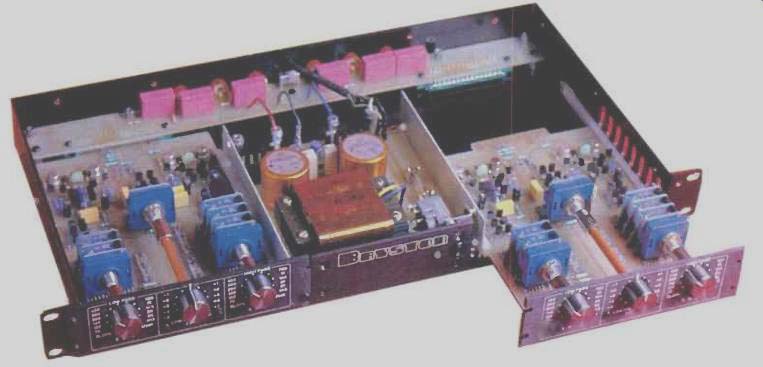
The search for the ultimate sound system inevitably leads to speaker systems employing electronic crossover systems ahead of the amplifiers. There are a number of reasons for this. Most obviously, it places the individual drivers under much more direct control of the amplifiers. This technique also eliminates the increased distortion in the crossover region caused by high signal current flowing in the reactive crossover components. Apart from the .high distortion they cause, the electrolytic capacitors, iron core chokes and large resistors normally used in speaker's internal crossovers simply don't lend themselves to close tolerance manufacture.
The components in an electronic crossover allow much closer control of the actual crossover frequencies, which can improve imaging. Thus, more than ever today, the finest speakers have provisions for 2-way or multi way amplification, with electronic crossovers required, and instructions included as to how the crossover must be set for optimal performance. The only difficulty, in the past, has been the task of obtaining a crossover unit with sufficient flexibility to follow these instructions precisely.
Bryston s Model 10B Electronic Crossover combines ideal signal-handling with an enormously flexible control function. Simple, direct front panel switches allow any crossover curve to be set instantly, and the signal purity is always maintained.
The Model 10B features independently selectable crossover points for high-pass and low-pass, in case the speaker installation requires slightly overlapped, (or slightly staggered), response curves for the drivers. You can also independently select crossover slope, from 6, 12, or 18 dB/Oct., where one driver requires a faster cutoff than another in the same system.
The crossover may be used in any of three internal connections: 2-way stereo, 3-way mono, and a special configuration, 2-way mono. This last cascades the low-pass and the high-pass sections and allows the selection of unusual crossover curves, including, "dual-slopes", where the crossover point is effected at a shallow rolloff, and the stop band is rolled off rapidly thereafter. It also permits the increasingly popular Linkwitz-Riley alignment with steep rolloff curves, 12, 24, or 36 dB/Oct.
All crossover selections are extremely accurate and repeatable, being implemented with 1% selected metal-film resistors and polystyrene capacitors. All switches are heavily gold-plated, for lifetime protection from corrosion. The level-controls are precise 1 dB increments, also derived from gold-plated switches and 1% metal-film resistors. Most important, however, is that the Bryston 10B Crossover uses NO integrated circuits in the signal path. All internal buffer and amplification stages are Bryston's exceedingly linear and superbly quiet discrete op amp circuitry. This means the signal is always maintained as "Audiophile Quality", with stability and freedom from noise and distortion un approached in normal equipment.
In addition to the flexibility and sound-quality built into the Bryston 10B crossover, individual channels are built as front-removable modules, as is the power-supply. This incidentally allows the easy implementation of special modules in the future, such as subwoofer drivers, preamplifiers, switching subsystems, etc. It also means the crossover may be purchased without its power-supply, for connection to the power-supply of another Bryston product, such as a second crossover, or the model 11B/12B Preamplifier, via a convenient rear-panel receptacle.
From the point of view of adaptability, flexibility and signal integrity, the Bryston 10B Electronic Crossover system is the ideal choice for the widest possible range of multi-way speaker installations.
POWER AMPS
MODEL 2B LP

Bryston's first exploration into audio, over a decade ago, was a power amplifier intended to prove our theory that amplification which was free of cost-cutting compromises, which displayed excellent open-loop linearity, would be audibly superior to amplification which obtained good numerical specifications from a compromised circuit by virtue of large amounts of feedback. This was, at that time, an almost heretical idea. Long term comparison tests were run at a large recording studio, using the biggest and best known amplifiers of the day. The result was that the studio ordered Bryston amplifiers for its monitor systems, although they were hardly more than breadboard prototypes at the time. Even in this rough form, Bryston's linearity proved audibly cleaner and more musical than the most respected products on the market. Clearly here was the beginning of a trend. Bryston has expanded on this theme ever since.
Included in our original theory were a number of design factors; independent power-supplies, very high output current capability, voltage-gain in the output section, and several other approaches intended specifically to linearize the open-loop gain, including complementary output circuitry. (Complementary means employing opposite polarities of transistor on opposing halves of the waveform. Quasi complementary employs the same polarity of output device on each half, and requires a signal phase reversal to drive one side, compromising linearity). These advances are still in use in all Bryston amplifiers. In addition, we have expanded our concept of full complementarity to include all stages, and have adopted a novel output section which is actually quad-complementary. This new output section, which employs both polarities of transistor on each half of the output drive circuit, yields a dramatic improvement in linearity and musical accuracy. This is reflected in extremely low distortion figures, obtained without massive amounts of feedback. I.M. distortion, which we feel is an excellent indicator of an amplifier's steady-state accuracy, is so low as to be nearly impossible to measure.
Further solidifying Bryston's low-open-loop distortion philosophy, we select and match all input transistors to less than 1% tolerance, employ only metal-film resistors, use polystyrene capacitors in signal-path circuitry. Finally, we hand adjust each and every amplifier to the absolute optimum performance.
MODEL 3B
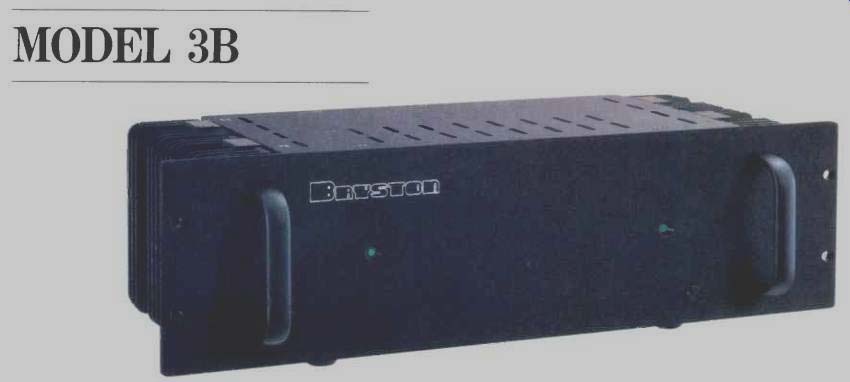
MODEL 6B

Of course, the proof is in the listening. Bryston sells over half of its production to professionals. We find that professionals are first attracted to Bryston by its reputation for reliability, but they are convinced by its sonic quality. The recording and broadcast industries, motivated by recent developments in low-distortion, wide range source material, have become very sophisticated, even audiophile-oriented. Bryston products have become so popular among these groups that there is an excellent chance that your favorite recording was monitored on Bryston equipment at the studio and later transmitted from stations using the same Bryston components on their monitors. Our reliability is so well-known that many touring bands use Brystons on the road as well. In fact, you could be listening to a Bryston chain all the way back to the amplified instruments themselves.
The reliability to which we referred above is not a matter of luck. It is our scientific application of proven methods. We use statistical mean-time before-failure analysis, studies of stress on component longevity, vibration-resistance in attachment methods, even the metallurgy of, and oxygen exclusion in, electrical connections. We know how to make a product fool-proof, and we know how to test for potential problems. Every amplifier Bryston makes is connected to a very high-stress combination of load and signal, which engages the protection mechanisms continuously. They are "burned-in" this way for more than 4 days: 100 hours. Although nearly all pass this test without incident, the point is, we don't want you to receive the one which might not have.
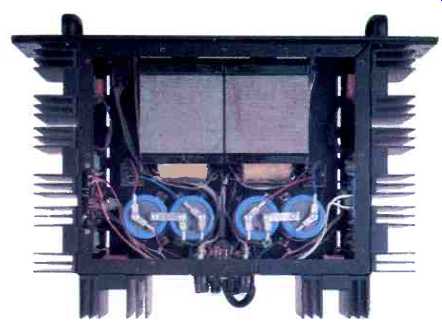
MODEL 4B
DUAL POWER SUPPLIES
All Bryston amplifiers, from our 50-watt per channel 2B, to the blockbuster 6B at 800 watts into 1 or 4 ohms, employ separate power supplies for each channel. Each supply could be capable of powering both channels to their full 8 ohm specifications. Keeping the power separate, however, yields a worthwhile, even dramatic improvement in image firmness and overall clarity. This is because the channels cannot develop any cross-talk or intermodulation through the power-supply.
ACCESSORIES
Bryston believes that equipment which sounds cleaner will measure better, and vice versa. That's why we build all our components with the best materials and the most performance effective technology. We feel it is important to retain this level of quality in all aspects of the signal chain. Bryston accessories maintain this link without compromise.
Moving coil cartridges display several sonic advantages over moving magnet type cartridges. The primary reason is that the magnet structure is many times larger, since the magnet is stationary, not a part of the tiny cantilever which traces the groove. A larger magnet allows more signal power to be generated, at lower electrical distortion, but since the coil is on the cantilever, and thus tiny, the voltage is lower. (The current, of course, is much higher). Since current can be transformed into voltage, a transformer is the ideal way to capture the improved signal-to-noise ratio this high signal power allows. The Bryston TF-1 transformer will deliver a signal from your moving coil cartridge to your phono preamplifier with lower noise and lower overall distortion at these small signal levels, than any active step-up device. The TF-1 is available in two gain configurations, (16.5 or 22.5dB), and is internally restrappable.
It is identical to the internal moving-coil stage in the Bryston 12B, and is an ideal match to the .5B, or to any preamp which requires a flawless moving-coil interface.
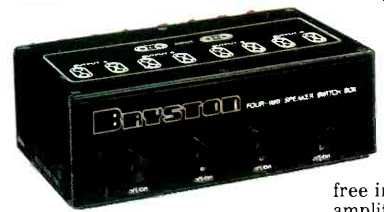
The Bryston line of speaker switchboxes uses massive switch assemblies, which stand up to the high current capabilities of Bryston amplifiers. High pressure contacts maintain ultimately low contact resistance, and gold-plated input and output connectors assure a distortion free interface between amplifier and loudspeaker.
Separate grounds between channels allow the use of bridged amplifiers. Models are available for 2 speakers plus headphone, 3 speakers plus headphone, and 4 speakers. If you require speaker switching, don't use just "any" switchbox; use a Bryston to maintain the clarity and musical accuracy of your system.
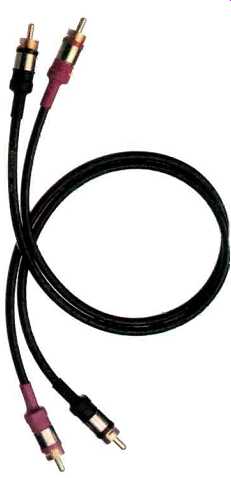
In cable interconnects there are 4 basic parameters which can affect waveform
accuracy; contact linearity, cable resistance, capacitance, and inductance.
Contact linearity is a function of corrosion in the connection, which can
be completely prevented by the heavy gold plating used in all Bryston connectors,
since gold is an inert metal.
The cable resistance and inductance of normal interconnect wires are negligibly low in relation to the source and input resistances they contact, but capacitance can affect performance since it acts as an increasing load at high frequencies. Bryston cables have extremely low capacitance (about 15pf per foot), and in addition, the dielectric is a foamed polymer, which is largely air, (the only "perfect" dielectric). A Bryston preamplifier can feed up to a quarter mile of Bryston cable without changing its bandwidth or distortion specifications. Using Bryston cables will assure you of maintaining all the performance built into your Bryston system.
Specifications: 2B-LP, 3B, 4B and 6B power amplifiers
DISTORTION: Harmonic: Less than 0.01% (for 6B 0.02%) from 20 to 20kHz at rated power.
IM: Less than 0.01% from 10 milli watts to full rated power.
Noise: 100 db below full output.
Crosstalk: Below noise 20 to 20kHz.
SLEWING RATE: Greater than 60 volts per microsecond.
POWER BANDWIDTH: Less than 1 Hz to over 100kHz.
DAMPING FACTOR: Over 500 at 20 Hz, ref. 8 ohms.
INPUT SENSITIVITY AND IMPEDANCE FOR 2B-LP, 3B, 4B RESPECTIVELY: 0.75 volt in for full output 50 k ohms.
1 volt in for full output, 50k ohms.
1.25 volts in for full output, 50 k ohms.
FEATURES:
1. Bridging switch.
2. Regulated power supplies.
3. Each channel separated back to the line-cord.
4. Dual-colour LED pilot-lights and clipping indicators; green changing to red at clipping.
5. Will deliver full output to any phase angle at 4 ohms or higher.
6. Warranty: 5 years parts and labor, shipping one way.
BRYSTON 2B-LP
Basic Stereo Power Amplifier
50 watts per channel, 8 ohms.
100 watts per channel, 4 ohms.
200 watts, bridged, 8 ohms.
Over 1600 cm^2 of heat-sinking; (over 3200 cm^2 with chassis). 19" x 1.75" x 10", wt. 18 lbs.
48.25 cm x 4.44 cm x 25.4 cm, wt. 8 kg.
BRYSTON 3B
Basic Stereo Power Amplifier
100 watts per channel, 8 ohms.
200 watts per channel, 4 ohms.
400 watts, bridged, 8 ohms.
Over 3200 cm2 of heat-sinking; (over 6400 cm^2 with chassis). 19" x 5.25" x 9", wt. 35 lbs.
48.25 cm x 13.33 cm x 22.85 cm, wt. 16 kg.
BRYSTON 4B
Basic Stereo Power Amplifier
250 watts per channel, 8 ohms.
400 watts per channel, 4 ohms.
800 watts, bridged, 8 ohms. (More than 1 horsepower).
Over 6400 cm^2 of heat-sinking; (over 9600 cm^2 with chassis). 19" x 5.25" x 13.5", wt. 50 lbs.
48.25 cm x 13.33 cm x 34.3 cm, wt. 23 kg.
BRYSTON 6B
Basic Mono Power Amplifier
Rated Distortion: Less than .02% I.M. or THD from 20-20 KHz at rated power or below.
Rated Power: 500 watts 8 ohms 800 watts 4 ohms 500 watts 2 ohms 800 watts 1 ohm 6400 cm^2 of heat sinking, etc.
19" x 5.25" x 13.5", wt. 50 lbs.
48.25 cm x 13.33 cm x 34.3 cm, 23 kg.
Specifications:
.5B, 11B* and 12B preamplifiers
DISTORTION: (Any Input, to any Output); Less than .005%, IM or THD, any Frequency from 20-20KHz, at rated output or below.
Rated Output: 10 volts RMS minimum, from Tape or Main Output.
(Typically 14 volts RMS available).
Rated Noise: (input shorted)
Phono; -80 dBA Referred to an input of 5 millivolts RMS @ 1KHz.
High Level inputs;-95 dBA referred to an input level of 500 mv at 1 KHz.
RIAA Accuracy: Within less than ± 50 mB (.05 dB) from 20-20KHz inclusive.
Frequency Response: High Level Section; within less than : ±50 mB from 20-20 KHz inclusive.
*without MC Transformer.
12B MC Transformer Section
DISTORTION: Less than .005% 20-20 kHz with preamplifier driven to full rated output.
Noise: Equivalent to approximately 1000 ohm metal film resistor (Thermal noise greater than -85 dB below 0.6 mv input, unweighted).
Gain: 16.5 or 22.5 dB (internally restrappable).
Frequency Response:
Below 5 Hz to above 30 kHz, within less than ± 0.5 dB.
(adapted from Audio magazine, Oct. 1987)
Also see:
Bryston 4B NRB Amplifier (Equip. Profile, Aug. 1992)
Bryston 4B Amplifier (Equip. Profile, Nov. 1985)
= = = =